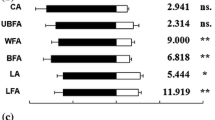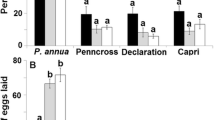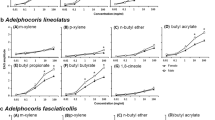Abstract
Many herbivorous insects use olfactory cues for host location. Extracts from Brassica napus L. have been shown to elicit electrophysiological and behavioural responses in the cabbage seedpod weevil, Ceutorhynchus obstrictus (Marsham) (syn. C. assimilis (Paykull)) (Coleoptera: Curculionidae). These include volatile products of the hydrolysis of glucosinolates. Here we present results of a laboratory olfactometer study examining the attractiveness of odours from flowering racemes and foliage of Sinapis alba L. (an inappropriate host for larval development), B. napus (an excellent host for larval development) and lines derived from S. alba × B. napus selected from colonization studies to demonstrate resistance or susceptibility. Results of this study indicate differential attraction of C. obstrictus to the odours of resistant and susceptible lines and suggest the role of hydrolysis products of glucosinolates, particularly the attractive effects of 2-phenylethyl isothiocyanate.

Similar content being viewed by others
References
Alford DV, Nilsson C, Ulber B (2003) Insect pests of oilseed rape crops. In: Alford DV (ed) Biocontrol of oilseed rape pests. Blackwell, Oxford, pp 9–41
Andréasson E, Jorgensen LB, Hoglund AS, Rask L, Meijer J (2001) Different myrosinase and idioblast distribution in Arabidopsis and Brassica napus. Plant Physiol 127:1750–1763
Bartlet E, Blight MM, Hick AJ, Williams IH (1993) The responses of the cabbage seed weevil (Ceutorhynchus assimilis) to the odour of oilseed rape (Brassica napus) and some volatile isothiocyanates. Entomol Exp Appl 68:295–302
Bartlet E, Blight MM, Lank P, Williams IH (1997) The responses of the cabbage seed weevil Ceutorhynchus assimilis to volatile compounds from oilseed rape in a linear track olfactometer. Entomol Exp Appl 85:257–262
Bartlet E, Kiddle G, Williams I, Wallsgrove R (1999) Wound induced increases in the glucosinolate content of oilseed rape and their effect on subsequent herbivory by a crucifer specialist. Entomol Exp Appl 91:163–167
Birch ANE, Griffiths DW, Hopkins RJ, Macfarlane Smith WH, McKinlay RG (1992) Glucosinolate responses of swede, kale, forage and oilseed rape to root damage by turnip root fly (Delia floralis) larvae. J Sci Food Agric 60:1–9
Blaney WM, Schoonhoven LM, Simmonds MSJ (1986) Sensitivity variations in insect chemoreceptors: a review. Cell Mol Life Sci 42:13–19
Blight MM, Pickett JA, Wadhams LJ, Woodcock CM (1995) Antennal perception of oilseed rape Brassica napus (Brassicaceae) volatiles by the cabbage seed weevil, Ceutorhynchus assimilis (Coleoptera: Curculionidae). J Chem Ecol 21:1649–1664
Bodnaryk RP (1992) Effects of wounding on glucosinolates in the cotyledons of oilseed rape and mustard. Phytochem 31:2671–2677
Bodnaryk RP (1994) Potent effect of jasmonates on indole glucosinolates in oilseed rape and mustard. Phytochem 35:301–305
Bonnemaison L (1957) Le charançon des siliques (Ceuthorhynchus assimilis Payk.), biologie et méthodes de lutte. Ann Épiphytes 4:387–543
Boodly JW, Sheldrake R (1982) Cornell peat-lite mixes for commercial plant growing. New York State College of Agriculture and Life Sciences, Cornell University, Ithaca
Buntin GD, McCaffrey JP, Raymer PL, Romero J (1995) Quality and germination of rapeseed and canola seed damaged by adult cabbage seedpod weevil, Ceutorhynchus assimilis (Paykull) [Coleoptera: Curculionidae]. Can J Plant Sci 75:539–541
Cárcamo HA, Dunn R, Dosdall LM, Olfert O (2007) Managing cabbage seedpod weevil in canola using a trap crop—a commercial field-scale study in western Canada. Crop Prot 26:1325–1334
Carlsson MA, Anderson P, Hartlieb E, Hansson BS (1999) Experience-dependent modification of orientational response to olfactory cues in larvae of Spodoptera littoralis. J Chem Ecol 25:2445–2454
Cole RA (1976) Isothiocyanates, nitriles, and thiocyanates as products of autolysis of glucosinolates in Cruciferae. Phytochem 15:759–762
Cook SM, Smart LE, Martin JL, Murray DA, Watts NP, Williams IH (2006a) Exploitation of host plant preferences in pest management strategies for oilseed rape (Brassica napus). Entomol Exp Appl 119:221–229
Cook SM, Watts NP, Castle LM, Williams IH (2006b) Determining the sex of insect pests of oilseed rape for behavioural bioassays. IOBC/WPRS Bull 29:207–213
Dickens JC, Moorman EE (1990) Maturation and maintenance of electroantennogram responses to pheromone and host odors in boll weevils fed their host plant or an artificial diet. Z Angew Entomol 109:470–480
Dmoch J (1965) The dynamics of a population of the cabbage seedpod weevil (Ceutorhynchus assimilis Payk.) and the development of winter rape. Part I. Ekologia Polska Ser A 13:249–287
Dosdall LM, Kott LS (2006) Introgression of resistance to cabbage seedpod weevil to canola from yellow mustard. Crop Sci 46:2437–2445
Dosdall LM, Moisey DWA (2004) Developmental biology of the cabbage seedpod weevil, Ceutorhynchus obstrictus (Coleoptera: Curculionidae), in spring canola, Brassica napus, in western Canada. Ann Entomol Soc Am 97:458–465
Dosdall LM, Moisey D, Cárcamo H, Dunn R (2001) Cabbage seedpod weevil factsheet. Alberta Agric Food Rural Dev Agdex 4:622–624
Doughty KJ, Kiddle GA, Pye BJ, Wallsgrove RM, Pickett JA (1995) Selective induction of glucosinolates in oilseed rape leaves by methyl jasmonate. Phytochemistry 38:347–350
Evans KA, Allen-Williams LJ (1992) Electroantennogram responses of the cabbage seed weevil, Ceutorhynchus assimilis, to oilseed rape, Brassica napus ssp. oleifera, volatiles. J Chem Ecol 18:1641–1659
Evans KA, Allen-Williams LJ (1993) Distant olfactory response of the cabbage seed weevil, Ceutorhynchus assimilis, to oilseed rape odour in the field. Physiol Entomol 18:251–256
Evans KA, Allen-Williams LJ (1998) Response of cabbage seed weevil (Ceutorhynchus assimilis) to baits of extracted and synthetic host-plant odor. J Chem Ecol 24:2101–2114
Evans KA, Bergeron J (1994) Behavioral and electrophysiological response of cabbage seed weevils (Ceutorhynchus assimilis) to conspecific odor. J Chem Ecol 20:979–989
Feeny PP (1976) Plant apparency and chemical defence. Recent Adv Phytochem 10:1–40
Finch S (1978) Volatile plant chemicals and their effect on host plant finding by the cabbage root fly (Delia brassicae). Entomol Exp Appl 24:150–159
Fox AS, Dosdall LM (2003) Reproductive biology of Ceutorhynchus obstrictus (Coleoptera: Curculionidae) on wild and cultivated Brassicaceae in southern Alberta. J Entomol Sci 38:365–376
Free JB, Williams IH (1978) The responses of the pollen beetle, Meligethes aeneus, and the seed weevil, Ceutorhynchus assimilis, to oilseed rape, Brassica napus, and other plants. J Appl Ecol 15:761–764
Gong F, Lian Y, Fung Y, Chau F (2004) Correction of retention time shifts for chromatographic fingerprints of herbal medicine. J Chromatogr A 1029:173–183
Harper FR, Berkenkamp B (1975) Revised growth-stage key for Brassica campestris and B. napus. Can J Plant Sci 55:657–658
Hill DS (1987) Agricultural insect pests of temperate regions and their control. Cambridge University Press, Cambridge
Jermy T, Hanson FE, Dethier VG (1968) Induction of specific food preference in lepidopterous larvae. Entomol Exp Appl 11:211–230
Kalischuk AR, Dosdall LM (2004) Susceptibilities of seven Brassicaceae species to infestation by the cabbage seedpod weevil (Coleoptera: Curculionidae). Can Entomol 136:265–276
Krishnan B, Dryer SE, Hardin PE (1999) Circadian rhythms in olfactory responses of Drosophila melanogaster. Nature 400:375–378
Lee KC, Cheuk WM, Chan W, Lee AWM, Zhao ZZ, Jiang ZH, Cai Z (2006) Determination of glucosinolates in traditional Chinese herbs by high-performance liquid chromatography and electrospray ionization mass spectrometry. Anal Bioanal Chem 386:2225–2232
McCaffrey JP (1992) Review of the U.S. canola pest complex: cabbage seedpod weevil. In: Proceedings, 1992 U.S. Canola conference, 5–6 March 1992. American Pedigreed Seed Company, Memphis, TN, pp 140–143
McCaffrey JP, O’Keefe LE, Homan HW (1986) Cabbage seedpod weevil control in winter rapeseed. University of Idaho, College of Agriculture, Cooperative Extension Service, Agricultural Experiment Station, CIC Series No. 782
McCaffrey JP, Harmon BL, Brown J, Brown AP, Davis JB (1999) Assessment of Sinapis alba, Brassica napus and S. alba × B. napus hybrids for resistance to cabbage seedpod weevil, Ceutorhynchus assimilis (Coleoptera: Curculionidae). J Ag Sci 132:289–295
McCloskey C, Isman MB (1993) Influence of foliar glucosinolates in oilseed rape and mustard on feeding and growth of the bertha armyworm, Mamestra configurata Walker. J Chem Ecol 19:249–266
Mewis I, Ulrichs C, Schnitzler WH (2002) Possible role of glucosinolates and their hydrolysis products in oviposition and host-plant finding by cabbage webworm, Hellula undalis. Entomol Exp Appl 105:129–139
Mithen R (1992) Leaf glucosinolate profiles and their relationship to pest and disease resistance in oilseed rape. Euphytica 63:71–83
Moyes CL, Raybould AF (2001) The role of spatial scale and intraspecific variation in secondary chemistry in host-plant location by Ceutorhynchus assimilis (Coleoptera: Curculionidae). Proc R Soc Lond 268:1567–1573
Moyes CL, Collin HA, Britton G, Raybould AF (2000) Glucosinolates and differential herbivory in wild populations of Brassica oleracea. J Chem Ecol 26:2625–2641
Porter AJR, Morton AM, Kiddle G, Doughty KJ, Wallsgrove RM (1991) Variation in the glucosinolate content of oilseed rape (Brassica napus L.) leaves. I. Effect of leaf age and position. Ann Appl Biol 118:461–467
Rask L, Andréasson E, Ekbom B, Eriksson S, Pontoppidan B, Meijer J (2000) Myrosinase: gene family evolution and herbivore defence in Brassicaceae. Plant Mol Biol 42:93–113
Rochfort SJ, Trenerry VC, Imsic M, Panozzo J, Jones R (2008) Class targeted metabolomics: ESI ion trap screening methods for glucosinolates based on MSn fragmentation. Phytochem 69:1671–1679
Ross D, Brown J, McCaffrey J, Davis JB (2006) Cabbage seedpod weevil resistance in canola (Brassica napus L.), yellow mustard (Sinapis alba L.) and canola × yellow mustard hybrids. In: Proceedings of American Society Agronomy-Crop Science Society of America—Soil Science Society of America International Annual Meetings, Indianapolis. November 12–16, 2006
SAS Institute (2005) SAS, version 9.1. SAS Institute, Cary
Schoonhoven LM (1969) Sensitivity changes in some insect chemoreceptors and their effect on food selection behavior. Proc Sec Sci K Akad v Wetensch te Amst C 72:491–498
Shaw E (2008) The detection of biochemical markers for cabbage seedpod weevil (Ceutorhynchus obstrictus) resistance in Brassica napus L. × Sinapis alba L. Germplasm. M.Sc. thesis, University of Guelph, Guelph, 155 pp
Shaw EJ, Fletcher RS, Dosdall LL, Kott LS (2009) Biochemical markers for cabbage seedpod weevil (Ceutorhynchus obstrictus (Marsham)) resistance in canola (Brassica napus L.). Euphytica 170:297–308
Smart LE, Blight MM (1997) Field discrimination of oilseed rape, Brassica napus volatiles by cabbage seed weevil, Ceutorhynchus assimilis. J Chem Ecol 23:2555–2567
Smart LE, Blight MM, Hick AJ (1997) The effect of visual cues and a mixture of isothiocyanates on trap capture of cabbage seed weevil, Ceutorhynchus assimilis. J Chem Ecol 23:889–902
Tansey JA (2009) Mechanisms of cabbage seedpod weevil, Ceutorhynchus obstrictus, resistance associated with novel germplasm derived from Sinapis alba × Brassica napus. PhD thesis, University of Alberta, Edmonton, 325 pp
Tansey JA, Dosdall LM, Keddie BA, Noble SD (2009) Contributions of visual cues to cabbage seedpod weevil, Ceutorhynchus obstrictus (Marsham) (Coleoptera: Curculionidae), resistance in novel host genotypes. Crop Prot. doi:10.1016/j.cropro.2009.11.005
Tollsten L, Bergstrom G (1988) Headspace volatiles of whole plant and macerated plant parts of Brassica and Sinapis. Phytochemistry 27:4013–4018
Ulmer BJ, Dosdall LM (2006) Spring emergence biology of the cabbage seedpod weevil (Coleoptera: Curculionidae). J Appl Entomol 99:64–69
Visser JH (1986) Host odor perception in phytophagous insects. Ann Rev Entomol 31:121–144
Walczak B, Kelm M, Klukowski Z, Smart LE, Ferguson AW, Williams IH (1998) The effect of trap design and 2-phenylethyl isothiocyanate on catches of stem weevils (Ceutorhynchus pallidactylus Marsh and C. napi Gyll.) in winter oilseed rape. OILB WPRS Bull 21:141–146
Acknowledgments
We are most grateful to Ross Adams, Jordana Hudak, Mike Gretzinger, Analea Mauro and Christina Gretzinger for capable technical assistance and to Dr. Héctor Cárcamo of Agriculture and Agri-Food Canada, Lethbridge Research Centre for access to facilities. We would also like to thank Drs. Bob Lamb and Maya Evenden for invaluable comments on this manuscript. Funding for this project was provided by the Canola Council of Canada, University of Alberta and grants to LMD from the Natural Sciences and Engineering Research Council of Canada and the Alberta Agricultural Research Institute.
Author information
Authors and Affiliations
Corresponding author
Additional information
Handling editor: Sam Cook.
Rights and permissions
About this article
Cite this article
Tansey, J.A., Dosdall, L.M., Keddie, A. et al. Responses of Ceutorhynchus obstrictus (Marsham) (Coleoptera: Curculionidae) to olfactory cues associated with novel genotypes developed by Sinapis alba L. × Brassica napus L.. Arthropod-Plant Interactions 4, 95–106 (2010). https://doi.org/10.1007/s11829-010-9087-2
Received:
Accepted:
Published:
Issue Date:
DOI: https://doi.org/10.1007/s11829-010-9087-2




